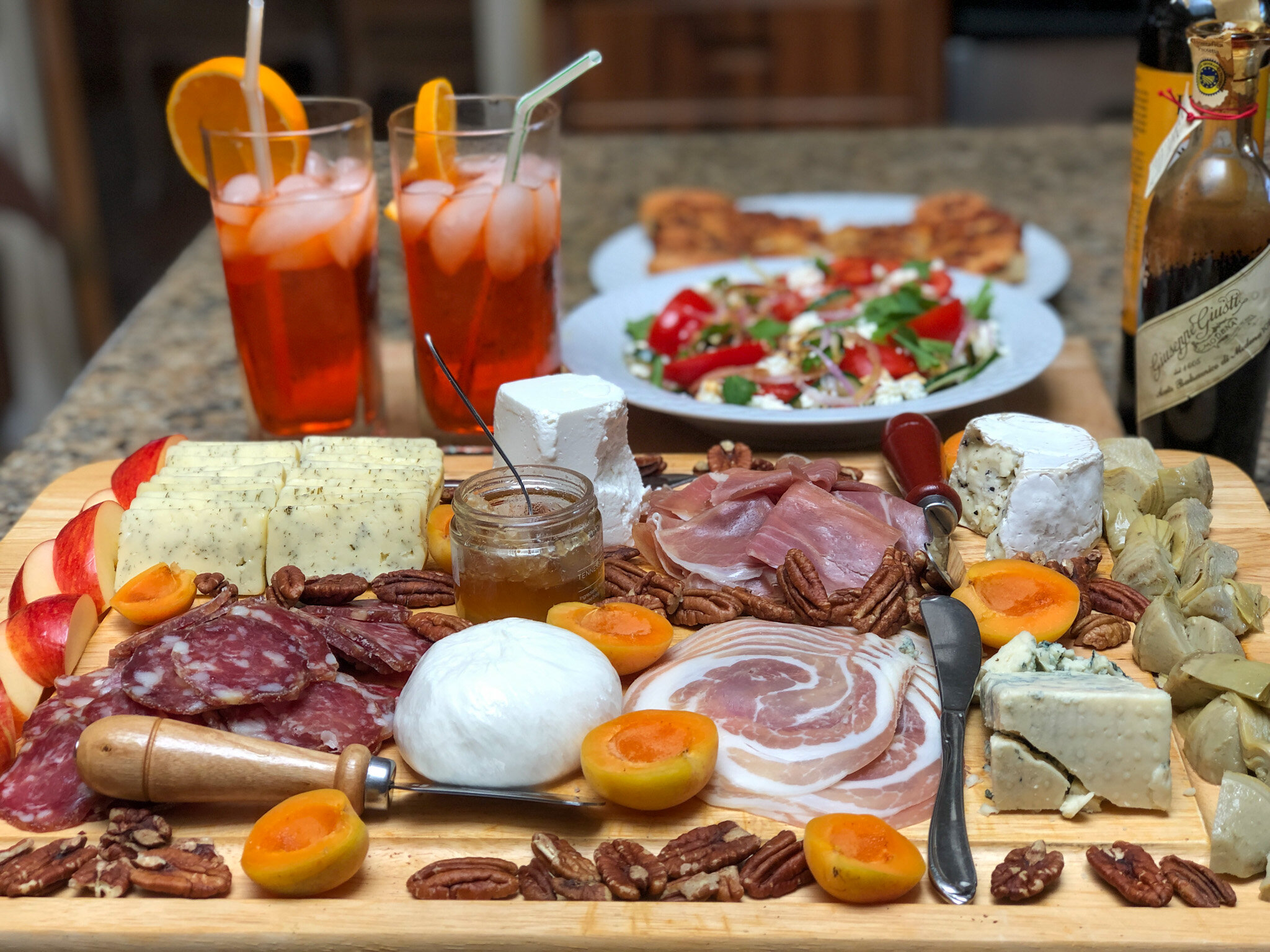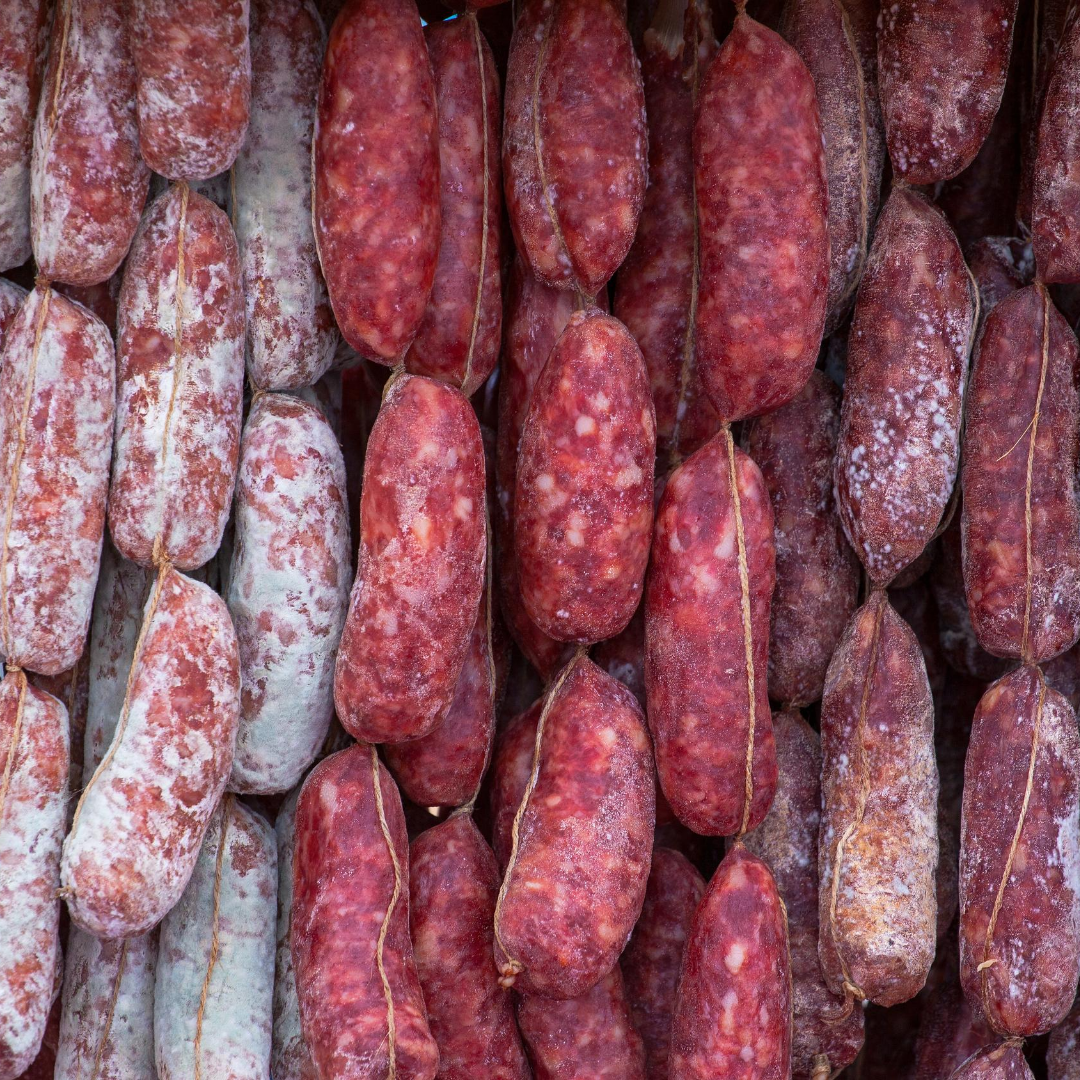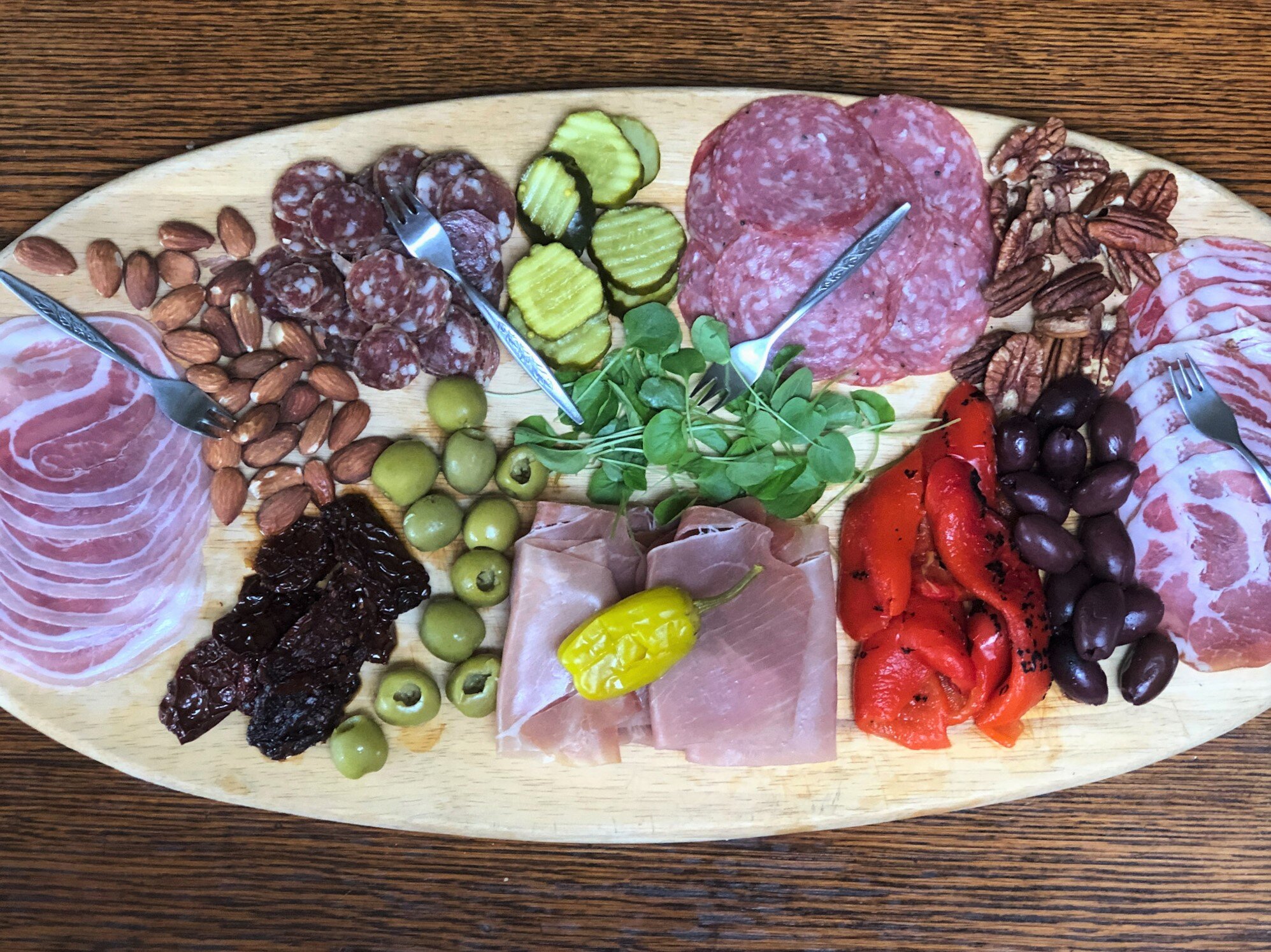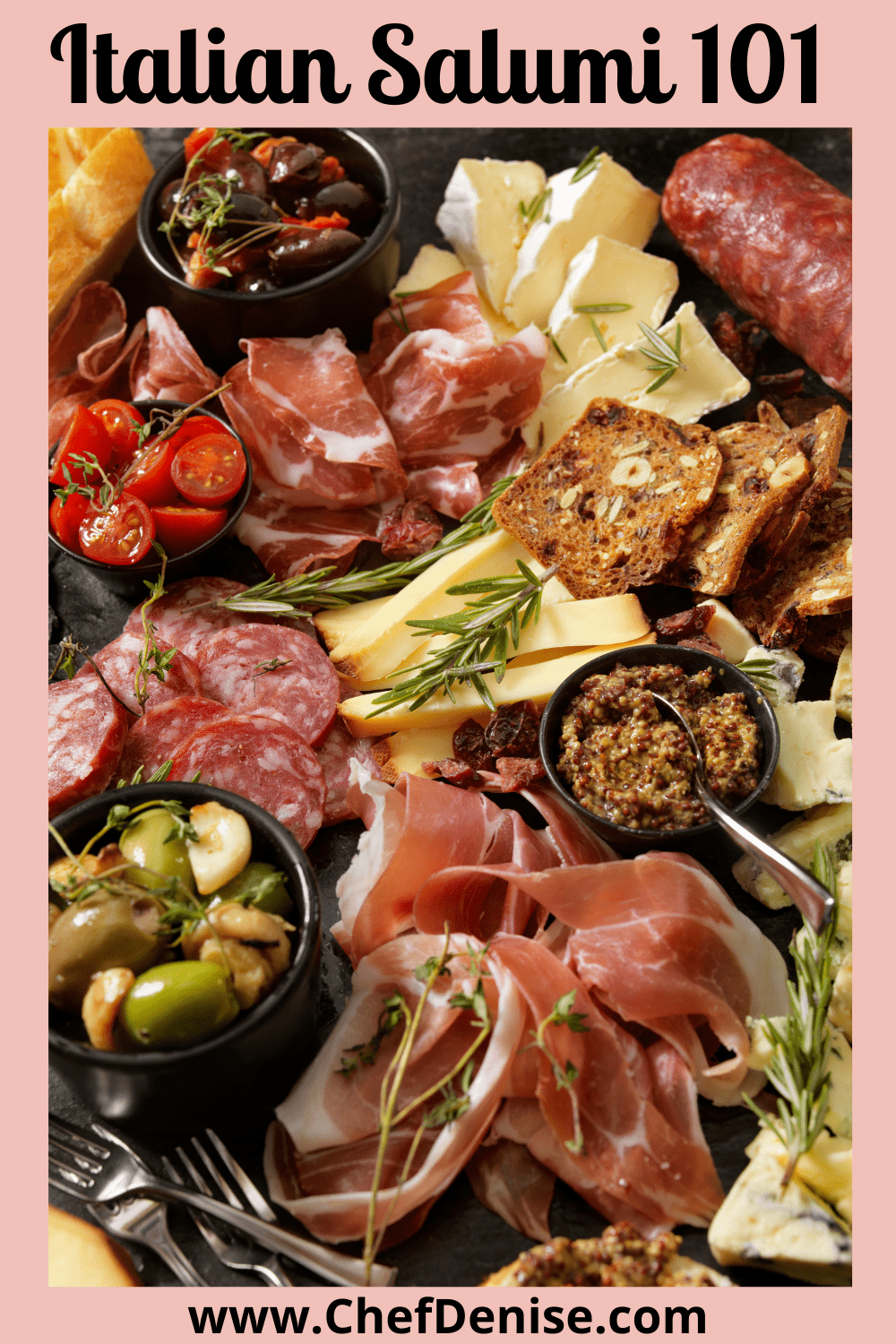Italian Charcuterie Board: Everything for the Ultimate Italian Salumi Board
I am a huge fan of Italian Charcuterie Boards or, as they call them in Italy, Salumi Boards! Throw in some cheese and I’m even happier. Add a refreshing glass of Italian sparkling wine, and I’m in heaven. For me, it doesn’t always have to be an appetizer or first course—this is my perfect dinner, best enjoyed outside.
Of course, I’d much prefer to be enjoying Italian food — including my salumi, in Italy! You will find regional Italian salumi throughout the country. Many of the best salumi are food products of Emilia-Romagna, known as Italy’s food valley.
However, you will be able to find a delicious selection most anywhere you may visit. From popular cities like Rome, Venice, Lucca, and Milan to the hidden gems in Puglia. And thankfully, they export some Italian salumi to the states so I can make a charcuterie board Italian-style at home in California.
Italian Charcuterie Boards 101
We will cover everything you need to know about making Italian Charcuterie Boards—the best Italian Charcuterie meats, accompaniments, and how to arrange the charcuterie platter.
For special holiday boards, see Christmas Charcuterie Board
Italian Charcuterie Board vs Italian Salumi Board
What’s the difference between an Italian Charcuterie Board vs Italian Salumi Board? Semantics—they are the same thing. Italian cold cuts are all in the category referred to as “salumi.” Salumi is the Italian word for charcuterie. The French word charcuterie (pronounced shar-coot-e-ree), means pork butcher shop or delicatessen. So, sometimes they are both just referred to as cold cuts.
Italian Salumi vs Salami
Italian salumi and Italian salami are not the same thing! Salumi sounds a lot like salami, but it includes so much more, as should your Italian Charcuterie Board! Salumi encompasses all Italian cold cuts, and while there are many types of salamis, they are a sub-category of salumi. So, all salami is salumi, but not all salumi is salami.
Should an Italian Charcuterie Board Include Cheese?
People often ask me, “should an Italian Charcuterie Board include cheese?” Technically speaking, charcuterie is just meat, however, I’m NEVER going to say no to cheese! And then you can call it an Italian meal!
Throw in a couple glasses of Aperol Spritz, and no one will argue semantics with you! I’ve never had an Italian cheese and meat not get along. So, for me, the best Italian charcuterie board has cheese!
Meat Choices for an Italian Charcuterie Board
When considering what meats to include on your Italian Charcuterie Board, think about creating a platter of varying textures, shapes, tastes, sizes, and colors. Just as you would for a cheese board. You will find lots of platters of charcuterie with prosciutto and salami, but I urge you to taste more of the less obvious Italian cold cuts and meats when ordering at a restaurant, or making your own Italian Salumi Board.
1. Culatello di Zibello
Culatello di Zibello tastes better than the best prosciutto you’ve ever had. Similar to Parma ham, it reigns from the area around Parma. More specifically, the foggy flatland near the Po River, which provides the perfect fog-laden climate to age this prized ham and impart the distinctive fragrances and flavors that make Culatello unique.
Made only from the thigh of the hind legs of select pigs of this region, the meat is very tender, lean, and rich in flavor. This delectable salumi is cured with salt, pepper, garlic, and white wine, and aged for at least 11 months. If you have Culatello available to you, include it on your Italian Charcuterie Board!
2. Prosciutto
Prosciutto di Parma and Prosciutto di San Daniele are the next best cured ham choices behind Culatello, and I would recommend having one or the other on your salumi platter. More widely available than Culatello (especially outside of Italy), prosciutto crudo has a delicious flavor, deep red color, and soft texture. It pairs well with cheeses and is quite tasty on bread or a cracker.
Prosciutto for an Italian Charcuterie Board
3. Salami
Salami is a 3-to-4-inch-wide sausage. It is traditionally made with seasoned ground pork (garlic, salt, wine, and spices) and cubes of fat that are stuffed into the pig's large intestine, which acts as a casing. Smaller salamis, called salamino, have a similar filling and are just 1-inch thick.
Today, there are many types of salami and salamino, and you can even include more than one on a charcuterie board. Again, shoot for variety! Consider Finocchiona, a Tuscan specialty with a slightly fennel flavor, or a truffle-accented option, or a spicy salami such as pepperoni.
4. Soppressata
Soppressata is similar to salami, but it primarily uses leftover cuts of pork pressed into a sausage. Although it originated in the south of Italy, you can find it country-wide, and the seasonings vary from region to region. It is coarsely ground and has larger chunks of pork and fat than salami.
Varieties of salami and Sopressata for an Italian Charcuterie Board
5. Nduja
Nduja makes a great addition to an Italian Cheese Board! Pronounced “en-doo-ya,” nduja is a spicy pork spread that easily takes care of the variety factor for texture, color, shape, taste, and size! And it’s delicious!
6. Coppa aka Capicola
Coppa is made from the neck or shoulder of a pig and is usually combined with herbs, spices, and wine. It is usually sliced thin like prosciutto, but the slice is more round and marbled, and distinct enough so that both can be served on the same board. Coppas also have regional flavors, and the ones from Calabria offer a nice spicy kick.
7. Bresaola
Bresaola has a deep red, almost purple color because it is made of beef that is air-dried, salted, and aged. It tends to be dry, and because of this, for a charcuterie board, I usually prefer prosciutto. However, bresaola served with olive oil or cheese can be a nice change.
8. Mortadella
Mortadella is not the bologna of your childhood, although its origins are from Bologna, Italy. The recipe for Mortadella di Bologna of finely ground pork sausage mixed with nutmeg, pepper, and pistachios dates back to the 1600s. It remains one of the most beloved foods from Bologna to this day! For it to have remained popular for as long as it has says something, right?
Creating an Italian Charcuterie Board
If you’re like me and can’t resist photoing beautiful meat and cheese trays, take a look at these charcuterie board quotes, they’re great for Instagram and social media!
Selecting the Italian meats for your Charcuterie Board
Do not try to include all of the above options on your Italian Charcuterie Board; a selection of 3 to 5 varieties is usually sufficient. Try to have different shapes, sizes, colors, and textures. Here’s a safe trio: Prosciutto, coppa, and a salami like Finocchiona will both taste delicious and be visually appealing.
As my nana always said, “thin slices please!” High quality salumi should always be thinly sliced. Thick salumi can be chewy and it’s wasteful.
Selecting the cheese (if you are including)
My number one rule is choose what you like. Two to three selections will usually suffice, and again, vary the size, texture, shape, and color if possible.
I always want a creamy cheese. If you want something Italian, start with Burrata or fresh mozzarella. If the creamy center of your burrata is too runny, you can put it in a small serving bowl.
A semi-firm like Fontina cheese with its slightly nutty flavor is always a hit. For a blue, Gorganzola is the perfect addition. Add hard cheese or one of the or aged cheeses like Grana Padano, Asiago, or Parmigiano Reggiano.
Or if you want to venture out, and want more information on selecting amazing cheeses, please check out my post on the best Italian cheeses.
Adding accompaniments
Adding accompaniments will enhance your board. Try to pair flavors that will complement your selection.
Pickled vegetables, marinated artichoke hearts, roasted red peppers, and Castelvetrano olives (green olives) are a few of my favorites. Below are some Charcuterie Board ideas to consider.
Finishers like mustard, jam, balsamic vinegar, and honey add depth of flavor and color to your presentation.
Truffle honey which is also one of my recommended gifts for foodies, is my must-have finisher—especially if there will be cheese on your Italian Charcuterie Board!
Caponata (Sicilian eggplant), fig jam and basil pesto are a few other favorites.
A good quality Italian bread and/or crackers can be part of your board, or put in a bowl or a bread basket.
Dried or fresh fruit and veggies can also be used as crackers for the keto crowd, and the colors easily perk up a platter. Cherry tomatoes, carrot sticks, strawberries, and grapes perk up any platter.
Nuts and garnishes in piles, small bowls, or sprinkles on the platter will help fill in the gaps. A few things you can usually find at the grocery store: Marcona almonds, dried white beans, and fresh basil.
Selecting the Right Board
When selecting how to present your charcuterie consider:
Portion size. Decide how much you need before choosing your board.
Where it will be placed. Make sure your board will fit in the space.
Decor. Will a wooden board or marble board work best, or maybe a decorative platter.
How to Put it All Together
Take the cheeses out of the fridge about an hour ahead to get them to room temperature. Space them out on the board. Slice the hard cheese and alternate the direction of the pieces for an interesting shape.
If you are using small serving bowls, fill them, and place on the board.
Add the meats in piles, roll around a cheese, or make a salami flower (see below). Or do all 3.
Fill in spaces with crackers and/or accompaniments.
How to make a salami rose
There are 2 ways to make a salami rose. Both are easy.
Method #1: Lay a slice of salami down flat. Place another on top so that it cover 3/4 of the original piece. Repeat with at least 10 more pieces in a straight line. Fold the salami in half like a taco. Then roll it up and you have a rose!
Method #2: Is just like Method #1, but uses the rim of a wine glass. This method works best if the salami covers even more than 3/4 of the underneath piece.
Try Our Most Popular Italian Recipes
Pasta di Frittata
Cacio e Pepe Pasta
Authentic Italian Marinara
Bolognese Sauce
Genovese Pesto Sauce
Lemon-Garlic Risotto with Prawns
Sloppy Giuseppe
Skinny Shrimp Scampi








